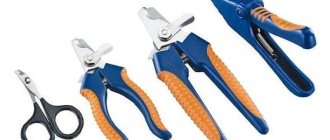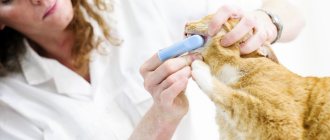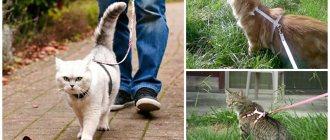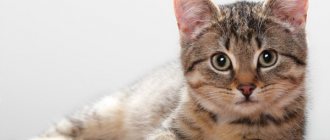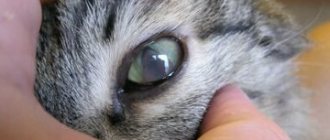Signs and main causes of constipation
Constipation is manifested by the following symptoms:
- no stool for more than 3 days;
- there is little stool and it is very dry;
- the cat sits on the tray for a long time, pushing, but to no avail;
- visits to the toilet are painful for the animal;
- flatulence;
- anxiety;
- the anus is swollen.
The causes of constipation are various:
- Most often, constipation is caused by improper nutrition (excess protein, lack of fiber, in kittens - switching to a different diet), stress, or the formation of a hairball, because the cat constantly licks itself. A newborn kitten cannot poop on its own. The cat licks his tummy, anal area and provokes the process of defecation. If a mother does not take care of her newborn children, they will have problems with bowel movements.
- Less common, but more dangerous causes are internal diseases, tumors and hernias in the intestine, deformation of the colon or rectum, and previous injuries (fractures).
- The most serious case when a cat does not pass feces is a volvulus or a foreign body entering the intestines.
An enema for a cat is an acceptable method of treating constipation only if it is caused by reasons related to improperly selected food or the formation of a hairball. If there are internal diseases or intestinal blockage, an enema is deadly. Therefore, a doctor should make a diagnosis and recommend treatment after examination.
What causes constipation?
Natural bowel movements in cats are observed 2-3 times a day. If the animal does not defecate for at least 1 day, feces will begin to accumulate in the large intestine and thicken, preventing new masses from coming out.
This can happen for several reasons:
the cat is not fed correctly: the diet does not contain components high in fiber, necessary for normal intestinal function;- with food, an animal can swallow a foreign object, which, once in the large intestine, disrupts the passage of feces;
- in long-haired breeds, the intestines can be clogged by hairballs accumulated in the stomach after licking;
- sometimes constipation is a concomitant symptom of one of the internal diseases associated with digestive disorders, endocrine system, obesity, which may be due to the kidneys, liver and even mental disorders.
It is necessary to take into account the structural features of the gastrointestinal tract. Such pathologies are congenital.
Contraindications
Enema - as a means of combating constipation is contraindicated in the following cases:
- tumors in the intestines;
- inflammatory process in the gastrointestinal tract;
- volvulus, acute obstruction;
- foreign body in the digestive tract (usually bone);
- pregnancy.
An enema is contraindicated for a cat if feces are excreted in small quantities and are black in color. This is a sign of internal bleeding in the upper digestive tract.
What is needed to perform an enema?
It is difficult for one person to give an enema to a cat at home. Need an assistant. Not a single cat will voluntarily agree to such a procedure.
To carry out you will need:
- A bulb (syringe), preferably with a rubber tip. The plastic nozzle can seriously injure your cat's anus if he resists, which he will. The volume of the pear depends on age. A 300 ml syringe is suitable for a large adult cat, and 150-200 ml for a kitten.
- The bulb can be replaced by a drip hose and a syringe. The hose has a small diameter and is much easier to insert into the cat's anus. The liquid is supplied into the tube with a large syringe without a needle.
- If you need to give a kitten an enema, you can use a pipette.
- Solution for administration (prepared independently or from a pharmacy).
- Lubrication. Vaseline, vegetable oil or baby cream are used as a lubricant.
- Rubber gloves, basin.
Enema technique
The cleaning procedure is carried out according to the following scheme:
- The pear is filled with the prepared solution. To do this, you need to squeeze it, lower the tip of the syringe into the solution and gradually release the pressure on the walls. For one procedure you need to take 50-100 ml of solution.
- It is recommended that the assistant place the cat on one arm and hold the paws with the other. If the pet is flexible, then it is more convenient for the owner to place the pet on his left hand. You may have to give the cat a sedative. It's difficult to cope without him.
- Lubricate the tip of the bulb with lubricant and release any air from the syringe.
- Slowly and carefully insert the tip into the anus. The direction is parallel to the spine. It is advisable to first make marks on the nozzle - 1 and 2 cm. For adult cats, the tip is inserted to a depth of 2 cm, for kittens - 1 cm. If the tip does not fit, you cannot press. You need to stop and introduce as much liquid as possible. For a 1-2 month old kitten, it is enough to administer 2-3 pipettes of solution. Abdominal massage will speed up bowel movements.
- After introducing the liquid, the tip of the syringe is carefully removed. You need to press the cat's tail to the anus and hold it with your finger.
To avoid damaging the colon, the solution is administered very slowly. Rapid application of the solution will cause discomfort in the pet and will not soften the stool.
You can allow your pet to go to the toilet directly into the basin.
If blood is found in the stool after an enema, urgent consultation with a veterinarian is required. Blood in feces is a sign of internal disease.
When should you not give an enema?
If the kitten has damage to the anus, intense pain when pressing on the abdomen, chronic pathologies of the heart or blood vessels, hemorrhoidal cones, bleeding of any etiology from the anus, an enema cannot be performed. Pregnant cats are also prohibited from undergoing this procedure.
You should not use enemas too often. After this, the microflora may be disrupted, mechanical damage and thinning of the walls are possible.
All information posted on the site is provided in accordance with the User Agreement and is not a direct instruction to action. We strongly recommend that before using any product, you must obtain a face-to-face consultation at an accredited veterinary clinic.
Enema solutions
An enema for a cat with constipation is done with the following solutions:
- Salt based. Dissolve 1 teaspoon of sea salt in 250 ml of water and heat until completely dissolved.
- A solution with baby soap, not very concentrated. The product works effectively, but cannot be used often - it has an irritating effect on the rectum.
- Tap water. Plain water can soften stool and promote its passage.
- Vaseline oil. Use in pure form or add a few drops to water. The oil coats the stool and lubricates the intestinal walls, making it easier for feces to pass through the digestive tract. 5-10 ml of oil is enough for an adult cat and 1 ml if you need to give an enema to a kitten.
- Chamomile decoction. The infusion is made at the rate of a tablespoon of dry chamomile per 200-300 ml of boiling water. The liquid is allowed to brew for 15 minutes, then filtered, cooled to a comfortable temperature and injected using a pear.
A prerequisite is that any solution for rectal administration should not be hot or very cold. The optimal temperature is 25-30 degrees.
It is recommended to resort to traditional methods of treatment if there are no medications in the house, such as microenemas, and there is no opportunity to buy them.
Pharmacy enemas
Using a syringe, tube and syringe is a complex process to perform. It is also important not to overfill the liquid. Without experience and knowledge, this is not easy to do. Therefore, it is better to start with pharmaceutical products. You can do enemas with solutions of lactulose-based medications, for example, Duphalac. Suitable for cats: Microlax and Proctum.
The most popular option is Microlax microenema. For an adult cat, it is enough to inject half the tube. To do this, remove the cap and lightly push the liquid towards the tip of the applicator to lubricate the tip. Then the applicator is smoothly inserted into the anus about 1.5 cm. You need to press hard on the tube, as it is quite hard. The microenema takes effect within 5-10 minutes. If there is no result, then the second half of the product is administered after 3 hours.
The Microlax tip is too large for a kitten, so the suspension is administered to the baby using an insulin syringe (1 ml). Half a syringe is enough.
Enema for a kitten
Artificial bowel cleansing is carried out not only for constipation.
Content
- Indications
- Causes of intestinal obstruction in kittens
- Treatment
- When should you not do an enema?
Indications
Indications for an enema may include poisoning, when it is necessary to urgently remove harmful substances from the body. In some cases, if there is severe exhaustion or if it is impossible to feed the kitten in the usual way during illness, a nutritional enema is used to maintain the animal’s strength. Among other things, enemas are:
- thermoregulatory - when it is necessary to lower body temperature;
- relaxing - to relieve intestinal spasms;
- medicinal - used if it is not possible to administer drugs in another way;
- diagnostic - for contrast fluoroscopy.
Causes of intestinal obstruction in kittens
Why does a pathological condition of the body occur when feces are retained in the intestines?
Chemostasis is the accumulation of chyme mass in the small intestine. The main factor leading to the disease is prolonged feeding of solid food. It can occur with a sedentary lifestyle, a lack of mineral salts in the body, or the absence or insufficient amount of water in the diet.
Coprostasis is a condition described as stagnation of feces in the lower part of the large intestine, resulting in slow movement or stoppage of feces. Often feeding bones to pets leads to this disease.
Due to gases accumulated in the intestines, the kitten's stomach becomes bloated and it cannot go to the litter box for more than two days.
Treatment
The procedure can be carried out at home only with full confidence that it will not harm the kitten, and constipation is caused precisely by errors in nutrition and has nothing to do with intestinal obstruction or volvulus. Otherwise, the matter may end in death!
To empty the intestines, you can use a laxative that helps soften stool, for example, Microlax (microenema, sold in a human pharmacy). The tip should be inserted 1-1.5 cm. The laxative effect occurs 5-15 minutes after taking the drug.
You can also use a regular small rubber syringe or a large disposable syringe with a wide cannula. It is best to carry out manipulations in the bathroom, or, as a last resort, on a floor that can be easily washed and disinfected (tiles, painted wood, etc.) It is most convenient to administer the enema on a flat surface. It can be done by one person, but it’s still better to call an assistant. First, warm water (25-30 C0) is filled into a rubber bulb and syringe, the tip is lubricated with Vaseline or any fatty cream, preferably baby cream (if this is not available, it is not forbidden to use ordinary vegetable oil). The volume of the injected solution should be from 50-100 ml.
When should you not do an enema?
There are conditions in which the use of cleansing enemas is strictly prohibited:
- inflammatory processes in the intestines;
- the presence of erosion on the mucous membranes of the digestive tract; bleeding;
- rectal prolapse;
- acute pathology of the abdominal organs.
The article was prepared by Yu.N. Novikova, intensive care veterinarian at MEDVET © 2021 SEC MEDVET




